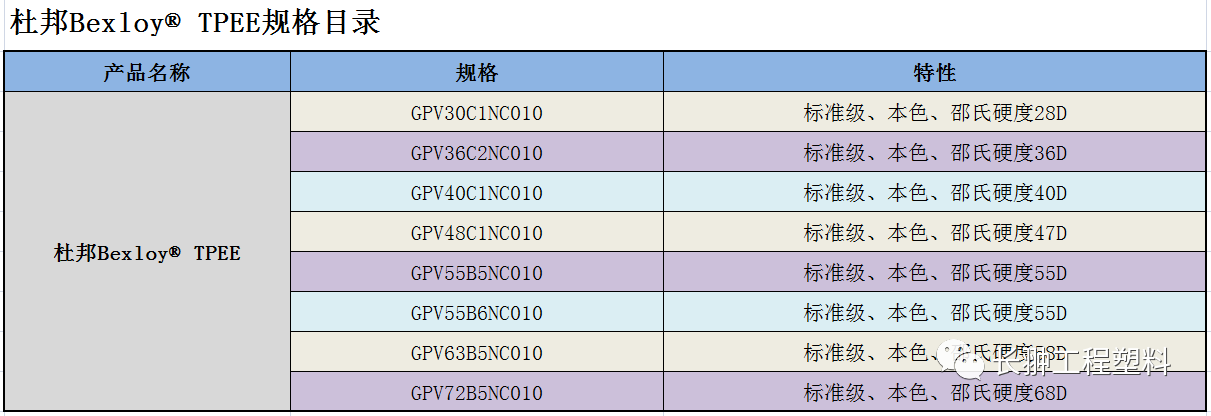Analysis of TPEE polyester elastomer for toughening and modifying various plastics
Release time:
2022-05-19
TPEE is a block copolymer containing polyester hard segments and polyether soft segments; where the polyether soft segments and non-crystalline polyester form an amorphous phase, while the crystalline polyester hard segments form crystalline microregions, acting as physical crosslinking points. TPEE has the elasticity of rubber and the strength of engineering plastics; the soft segments give it elasticity, making it like rubber; the hard segments provide it with processing performance, making it like plastic; compared to rubber, it has better processing performance and a longer service life; compared to engineering materials, it also has high strength characteristics, while offering better flexibility and dynamic mechanical properties. TPEE possesses the elasticity of rubber and the strength of engineering plastics, as well as good flexibility, high melt stability, and low melt viscosity. It can be used to enhance the low and high-temperature impact strength (toughness), flexibility, and compatibility of blended systems of other plastics, and can also provide a certain degree of elasticity. Due to the presence of ester bonds, TPEE is a polar polymer, thus it can be used to modify polar materials such as POM, PBT, and PET. It can also be blended with PVC, or with PP, polyacetal, and CO-olefin alternating copolymers, or with other elastomers, to improve the impact toughness of these products.
TPEE is a block copolymer containing polyester hard segments and polyether soft segments; the polyether soft segments and the non-crystalline polyester form an amorphous phase, while the crystalline microregions are formed by the partially crystalline polyester hard segments, acting as physical crosslinking points. TPEE has the elasticity of rubber and the strength of engineering plastics; the soft segments give it elasticity, making it like rubber; the hard segments provide it with processing performance, making it like plastic; compared to rubber, it has better processing performance and a longer service life; compared to engineering materials, it also has high strength characteristics, while having better flexibility and dynamic mechanical properties.
TPEE has the elasticity of rubber and the strength of engineering plastics, as well as good flexibility, high melt stability, and low melt viscosity. It can be used to improve the high and low temperature impact strength (toughness), flexibility, and compatibility of other plastic blends, and can also provide a certain degree of elasticity. Since TPEE contains ester bonds and is a polar polymer, it can be used to modify polar POM, PBT, PET, etc. It can also be blended with PVC, PP, polyacetal, and CO-olefin alternating copolymers, or blended with other elastomers to improve the impact toughness of these products.
1. TPEE modified POM, TPEE has good compatibility with POM, with a melting point close to that of POM, making it easy to process. Adding 3-5% can achieve good toughness. TPEE can also be used to make high-performance POM products, which have good toughness. It can be used to make noise-reducing gears, automotive parts, etc.
2. TPEE modified PBT/PET/PA, TPEE has good compatibility with PBT/PET/PA, with a melting point close to that of these materials, making it easy to process. The modified products are used in high-demand environments. For example, adding a chain extender to the blend of TPEE and PBT will yield better results.
3. TPEE modified PVC, TPEE has good compatibility with PVC. After adding TPEE, the low-temperature flexibility of PVC is significantly improved, and its resistance to bending is greatly enhanced, reducing the brittleness point. It improves wear resistance, tensile strength, elongation, hardness, and tear strength. As the TPEE content increases, the brittleness temperature and thermal deformation at high temperatures decrease, while mechanical properties such as modulus, elongation at break, hardness, wear resistance, tear strength, tensile strength, dynamic modulus, and impact strength increase. When the TPEE content is 75%, TPEE is dispersed in the continuous phase of PVC; when the TPEE content is 85%, the morphology of the blend is two continuous phases, with two crystalline phases and one glass transition temperature.

Tag:
Previous Page
Recommend News
2018-04-09
Share

